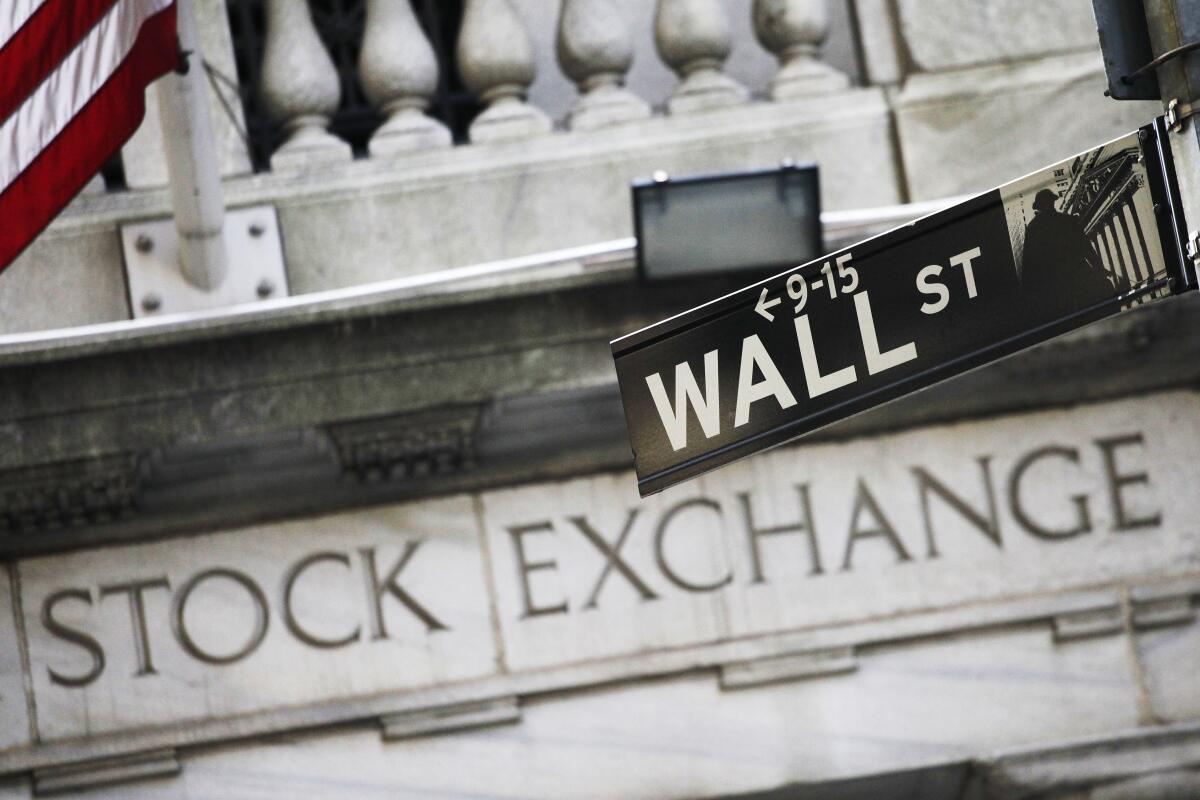Indexes end mixed as Netflix plunges

- Share via
Wall Street’s major stock indexes ended mixed Wednesday after another day of choppy trading, while Netflix lost more than a third of its value after reporting its first subscriber loss in more than a decade and predicting more grim times ahead.
The Standard & Poor’s 500 index slipped 0.1% after a late-afternoon fade, while the Nasdaq composite fell 1.2%. The Dow Jones industrial average rose 0.7%, having received a bump from IBM, which added 7.1% after reporting quarterly results that beat analysts’ estimates.
Netflix slumped 35.1% a day after the streaming giant reported its first decline in subscribers in more than a decade. The company also said it expects a steeper decline during the current quarter. Netflix is now considering changes that it has long resisted, including minimizing password sharing and creating a low-cost subscription option supported by advertising. The stock is now down 67% from the all-time high it reached in November.
Netflix’s stock price plunged 35%, to $226.19, after the streaming giant revealed it lost 200,000 subscribers in the first quarter.
The skid in Netflix, one of Wall Street’s Big Tech highfliers in recent years, weighed heavily on the S&P 500, outweighing gains elsewhere in the benchmark index, and hit the communication services sector the hardest, pulling it 4.1% lower.
“While it is in communication services, it is also a discretionary stock, clearly, in that it’s one of those things people buy because they want, not because they have to,” said Randy Frederick, vice president of trading and derivatives at Charles Schwab.
Technology firms, retailers and other companies that rely on consumer spending also weighed on the market. Chipmaker Nvidia fell 3.2% and Amazon dropped 2.6%.
Healthcare stocks made some of the biggest gains. CVS rose 2.7% and medical device maker Boston Scientific added 3%.
Banks and household product makers also bucked the market’s overall decline. JPMorgan Chase rose 0.4%, while Charmin and Dawn maker Procter & Gamble rose 2.7% after beating analysts’ quarterly earnings forecasts.
Tesla rose 4% in after-hours trading after reporting first-quarter net earnings that were more than seven times greater than a year earlier. The electric vehicle and solar panel company benefited from strong sales despite global supply chain kinks and pandemic-related production cuts in China.
All told, the S&P 500 slipped 2.76 points to 4,459.45, and the Nasdaq fell 166.59 points to 13,453.07. The Dow rose 249.59 points to 35,160.79.
Smaller-company stocks held up better than the broader market. The Russell 2000 added 7.42 points, or 0.4%, to end at 2,038.19.
Investors continue focusing on the latest round of corporate earnings as they try to determine how companies are dealing with high inflation and cost pressures. American Airlines and Union Pacific are due to report results Thursday.
Inflation has been putting increasing pressure on a wide variety of industries and squeezing consumers. Rising prices have prompted the Federal Reserve and other central banks to raise interest rates to help temper inflation’s effect. The Fed has already announced a quarter-percentage-point rate bump and Wall Street expects a half-percentage-point increase at its next meeting in two weeks.
“The market knows the Fed’s going to hike rates a bunch,” said Scott Wren, senior global market strategist at Wells Fargo Investment Institute. “But, the market is feeling pretty good that once we get to neutral, then in 2023 maybe you don’t go a lot further.”
Interest rates are considered “neutral” when they neither push nor restrict economic growth. Currently, investors expect rate hikes to increase the benchmark interest rate to somewhere between 2.50% and 3% by the end of the year, according to CME Group’s FedWatch tool.
Bond yields have been rising throughout the year as Wall Street prepares for higher interest rates. The yield on the 10-year Treasury note eased to 2.84% from 2.91% late Tuesday, but it’s still near its highest level since late 2018.
Higher bond yields have been pushing up mortgage rates and increasing pressure on an already tight housing market. The National Assn. of Realtors reported Wednesday that sales of previously occupied U.S. homes fell in March to the slowest pace in nearly two years as higher mortgage rates and already record-high prices discouraged would-be home buyers.
Russia’s invasion of Ukraine and the ongoing conflict has only added to the worries about rising inflation crimping economic growth. The conflict has pushed energy and commodity prices higher.
U.S. crude oil prices rose 0.2% on Wednesday and are up nearly 40% for the year, pushing gasoline prices higher. Wheat prices are up 41% for the year, and that has the potential to increase prices for a wide variety of food products globally.
Stocks have mostly struggled this year because of the confluence of concerns. Meanwhile, virus lockdowns in China are easing. Authorities in Shanghai allowed 4 million people to leave their homes, but the lockdowns have left the Chinese economy damaged.
More to Read
Inside the business of entertainment
The Wide Shot brings you news, analysis and insights on everything from streaming wars to production — and what it all means for the future.
You may occasionally receive promotional content from the Los Angeles Times.











